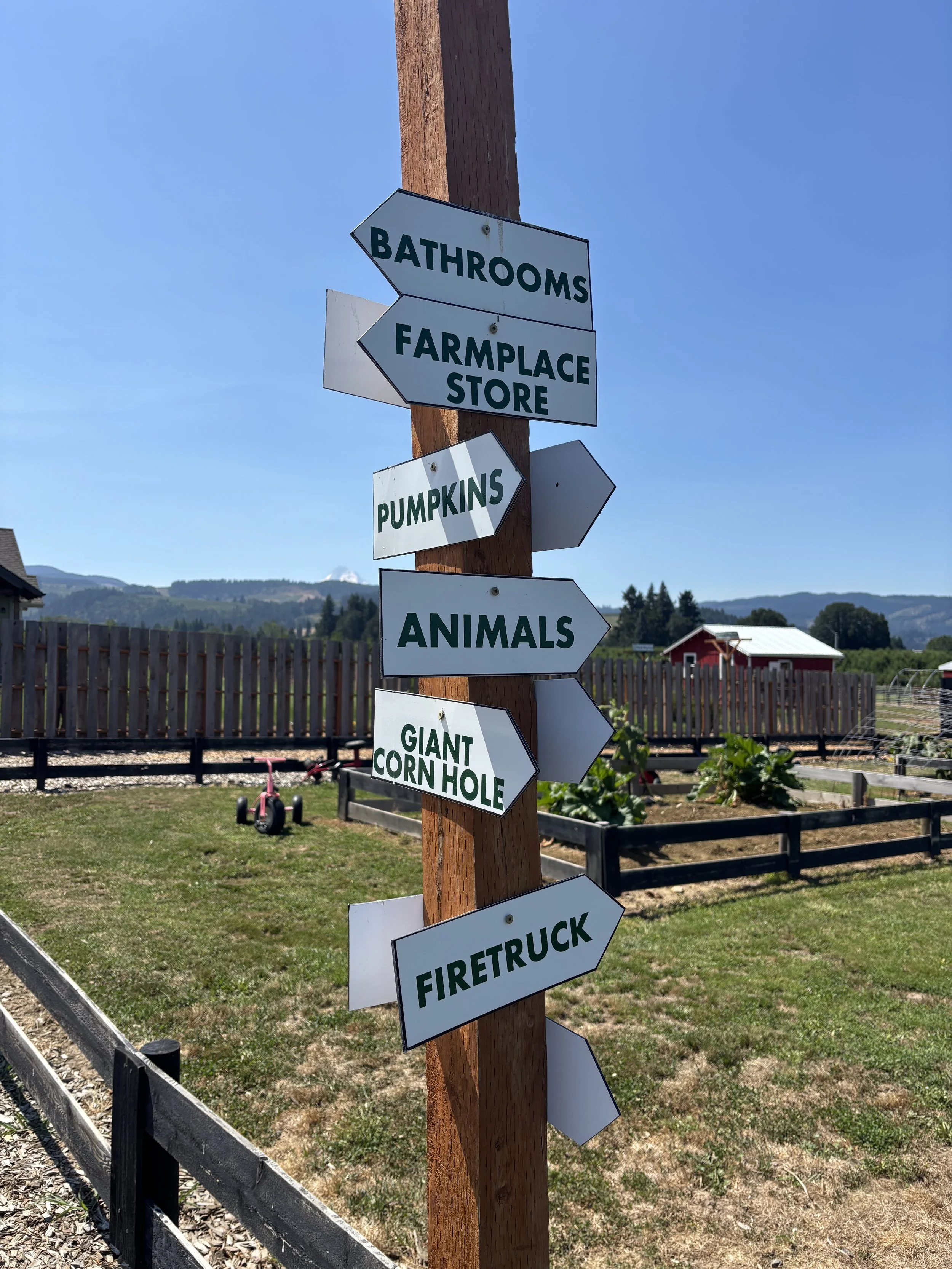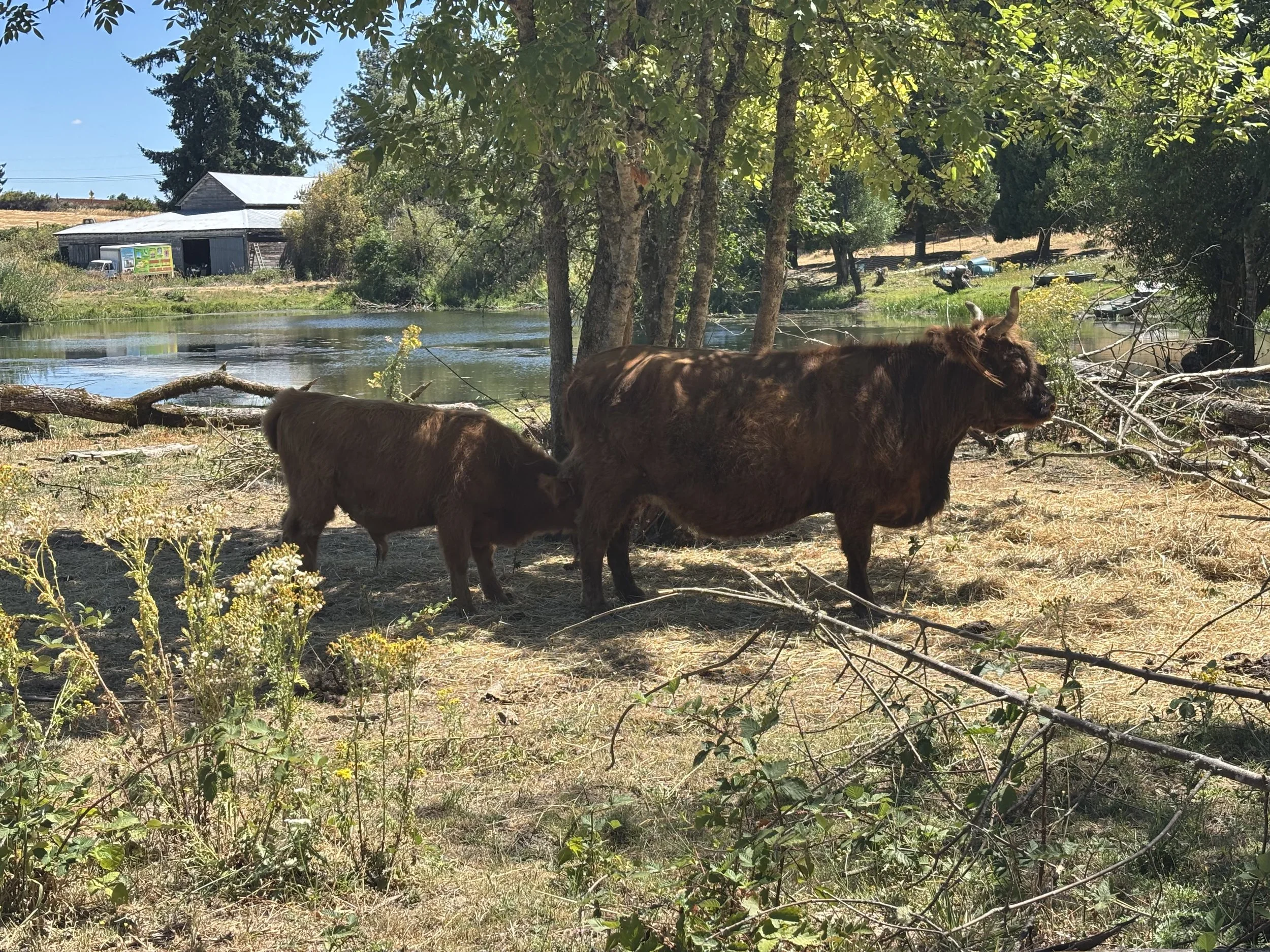Mat Jensen and his family live with their animals at On The Edge Farm in Dallas, Ore. (Khushboo Rathore)
Why Oregon’s Governor Had to Intervene on Pumpkin Patches
The latest rulemaking dispute is part of long-standing tensions over land use.
By Khushboo Rathore
August 15, 2025
DALLAS, Ore.—With tattoos wrapping around his arms and a baseball cap pulled low over his face, ex-Marine Mat Jensen cuts an imposing figure.
At least until he crouches down and the two Kunekune pigs on his 40-acre farm race over to him for their daily petting. Or when he’s almost knocked over by a miniature donkey affectionately leaning against his legs.
In 2021, Jensen and his wife, Ava, bought the abandoned property 12 miles west of Salem, naming it On the Edge Farm, where they grow produce for sale at their farm stand, welcome visitors for guided tours, and host a pumpkin patch. They were building a life as first-generation farmers when they were upended by unexpected news in late July.
Oregon’s Department of Land Conservation and Development had been asked by lawmakers to review the rules governing farm stands, particularly the restriction that only one-quarter of a farm stand’s income can come from events, retail items, or foodstuffs not produced by that farm. Small farmers across the state hoped the 25% limit would be loosened so they could drum up more revenues to smooth out the risks of their weather-dependent businesses.
Instead, they learned in July that the latest version of DLCD’s proposed rules were tougher, tightening farm stand revenue limits and adding requirements for parking studies and costly permits.
“Farmers who were already stretched and already taxed to the most, it’s not something that’s really feasible for people to afford,” Jensen said after hearing the bad news.
Farmers across the state, galvanized by social media postings by Topaz Farm on Sauvie Island in Portland, followed suit and encouraged people to send letters and emails to the agency and Gov. Tina Kotek.
Four days later, in response to a flood of messages, Kotek paused the rulemaking indefinitely.
But the conflict is still simmering.
Some of the activities available for visitors at the Packer Orchards Farm Place in Hood River, Ore. (Khushboo Rathore)
The Farm Place’s diverse residents attract visitors of all ages (Khushboo Rathore)
The current controversy is the most recent in a long string of property rights disputes in Oregon. In 1973, state lawmakers passed Senate Bill 100, a statewide land use plan aimed at protecting farmland and forests and preventing suburban sprawl. The landmark law also created the Land Conservation and Development Commission to enforce planning goals.
The law called for the establishment of urban growth boundaries around Oregon cities and has fueled tensions between landowners and conservation groups for five decades. On one side are those who support a strict interpretation of the laws and want to tighten farm stand rules to keep highly productive soil from being converted into tourism venues. But those who work the land say the additional income from farm stands and visitors to their farms gives farmers a crucial economic boost.
There are two main opposing interest groups in the farm stand debate: the Oregon Property Owners Association, a nonprofit that offers free legal help to landowners and generally opposes restrictions on privately owned land; and 1000 Friends of Oregon, a nonprofit land use watchdog created in 1974.
Exacerbating the dispute are murky state regulations. In general, the state requires a farm stand permit for activities outside “normal farm use”—anything beyond growing, harvesting and selling crops and livestock produced on the farm.
However, local governments have leeway to decide when a farmer just needs a farm stand permit or is engaged in more intensive businesses labeled “agritourism.” Such activities include music festivals and restaurants, which require additional permits. The current rules don’t clearly define the difference between farm stands and agritourism.
If events don’t relate directly to a farm’s crops or livestock, they should be considered a form of agritourism, says Jim Johnson, a former Oregon Department of Agriculture staffer who works for 1000 Friends. Agritourism would require documentation to show an event will not adversely impact nearby land by blocking machinery or harming the environment.
In order to avoid such scrutiny, some farmers try to hold their events with an existing farm stand permit, Johnson says. “They know that there’s probably issues with the impacts they’re going to have on surrounding farms and ranches.”
County planners have caused frustration and confusion among farmers across the state with inconsistent enforcement, says OPOA lawyer Samantha Bayer.
The Jensens’ farm, for instance, occasionally hosts educational tours for schools and private groups for a nominal fee. But Polk County doesn’t require them to have a farm stand permit.
In Hood River County, on the other hand, Tammi Packer, one of the owners of Packer Orchards, says she has had to deal with Hood River County officials constantly changing their farm stand guidance.
“I feel that Hood River has a much stricter voice on what they consider agritourism and what they don’t want,” Packer says.
About 10 miles away from Packer Orchards, McCarthy Family Farm actually wants more regulation and protection of agricultural land in Oregon. Mike McCarthy, a first-generation farmer, runs a commercial fruit orchard, mostly pear trees.
One of the problems with farm stands in Hood River, according to McCarthy, is that the county often doesn’t enforce its own regulations. For example, the county requires all parking for a farm stand to be on site. But McCarthy says he has had to deal with customers of nearby farm stands parking along rural roads, blocking his work trucks from leaving the orchard.
“It puts all the responsibility for monitoring all the agritourism in Oregon on the neighboring farms, and that’s really the challenge,” McCarthy says.
The problem with the state’s proposed rules, Bayer says, is that they would limit farmers’ ability to host events that do not directly relate to selling farm products, such as petting zoos and play structures. The proposed rules also limit sales of local artisan products like T-shirts and crafts, Bayer says.
Her group thinks there should be no limitations on income from farm stands or events at farms—but supports parking and infrastructure regulations.
McCarthy, who is part of a group of farmers and ranchers called Ag for Oregon, believes limiting music fests, restaurants, and the construction of new homes on farmland protects farmers from rising land prices. With too many freedoms, large companies may see an opportunity to turn profits through agritourism that would make farms unaffordable for the next generation, he says.
“What we’re going to do is just create, unfortunately, an elitist situation where only the very superrich can buy a farm,” McCarthy said.
When Gov. Kotek ordered a pause on the rulemaking process July 25, farmers across the state celebrated. The consensus among farmers and officials is that the decades-old farm stand rules need more discussion.
“There wasn’t enough conversation with the actual farmers on the ground before those rules were really being pushed forward,” Packer says.“It just needs to be an entire table conversation because agritourism in the United States has changed dramatically over the last 30 years.”
When the Jensen family bought their farm, they moved from a large home in McMinnville to a small studio apartment and worked outside jobs while they built their farm from scratch—putting up miles of fencing for their herd of cows and using animal waste to revitalize the soil.
Highland cows at On The Edge Farm in Dallas, Ore. (Khushboo Rathore)
Among the proposed farm stand rules are new clauses for infrastructure surrounding farm stands. These include changes to driveway surfaces and cutting down nearby trees as well as dealing with the costs of additional permits and inspections.
The Jensens say the proposed rules would have made continuing to operate their farm very difficult because it would have required them to shut down their yearly pumpkin patch—solely due to the additional time and costs of obtaining new permits.
No farm is running tours for school kids or operating fall pumpkin patches because it’s easy money, Mat Jensen says. Farming is the “worst career opportunity” economically he could imagine—people do it because they have a passion for it.
“Knowing we can impact people’s day or life in a positive way is also what keeps us going,” Ava Jensen said.




